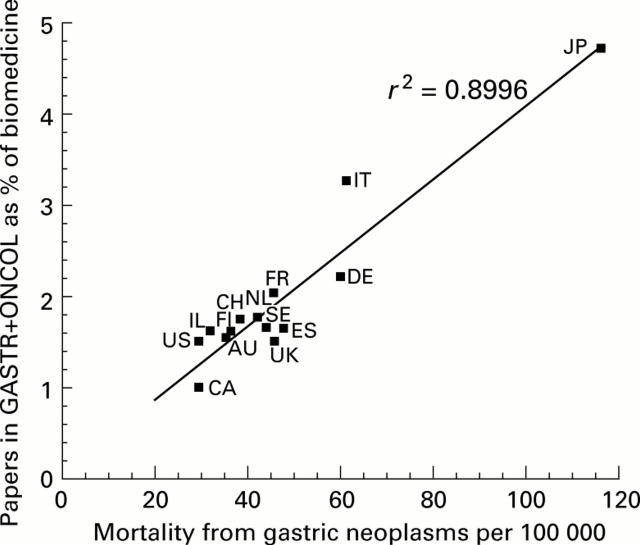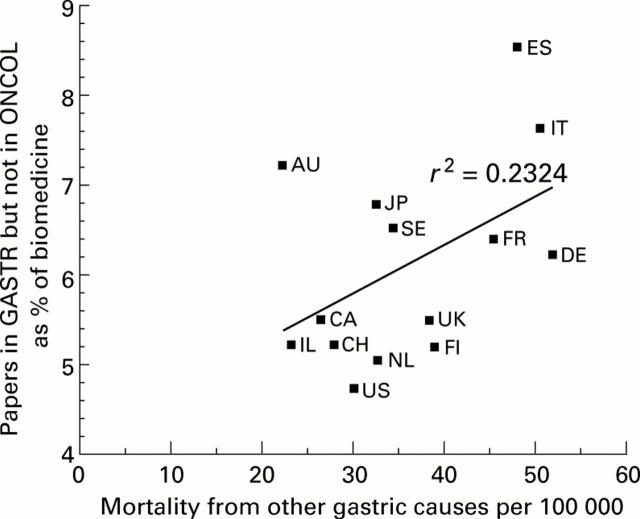Abstract
AIMS—To examine the volume and potential impact of gastroenterology research outputs from 1985 to 1998 from 14 developed countries; the overlap with research in cancer, infectious diseases, and genetics; and the funding sources for this research. To determine if countries' research outputs correlated with their burden of corresponding diseases and inputs to their research. METHODS—Selective retrieval of papers from the Science Citation Index and manual look up of a sample to determine funding sources. Classification of journals by four categories of research level (clinical/basic) and potential impact (low/high). RESULTS—Gastroenterology represents about 8% of world biomedical research but over 11% in Italy, Japan, and Spain. Its potential impact is highest (but declining) for the USA. It has increased noticeably in most European countries, particularly in Finland. Gastroenterology research has become more clinical in Japan, Spain, Australia, and the Netherlands but more basic in Canada, Germany, Finland, Israel, and South Africa. Funding comes primarily from national governments, followed by national private non-profit sources and industry but little industrial funding occurs in some countries. There is a strong and positive correlation between reported deaths from gastrointestinal neoplasms and countries' outputs of research in gastrointestinal oncology. CONCLUSIONS—Bibliometric analysis can reveal differences between countries in their research in a subject when a common methodology is applied to an international database. Variations in research methods in different countries can plausibly explain some of the variation in the potential impact of the work. Keywords: bibliometrics; funding; impact; mortality; research
Full Text
The Full Text of this article is available as a PDF (163.5 KB).
Figure 1 .
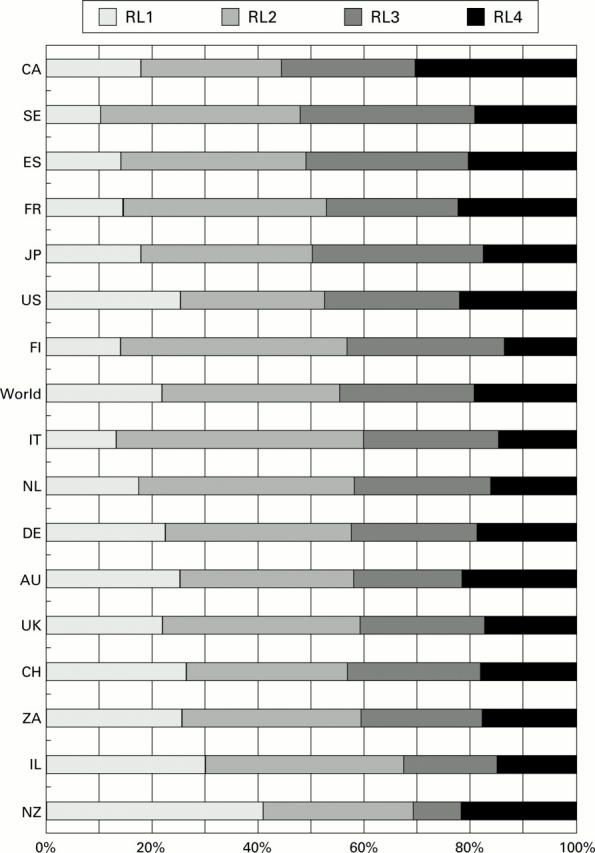
Distribution of gastroenterology papers from 16 countries (Australia (AU), Canada (CA), Finland (FI), France (FR), Germany (DE), Israel (IL), Italy (IT), Japan (JP), the Netherlands (NL), New Zealand (NZ), South Africa (ZA), Spain (ES), Sweden (SE), Switzerland (CH), the UK, and the USA) and the world by research level (RL, 1=clinical to 4=basic): 1997-98.
Figure 2 .
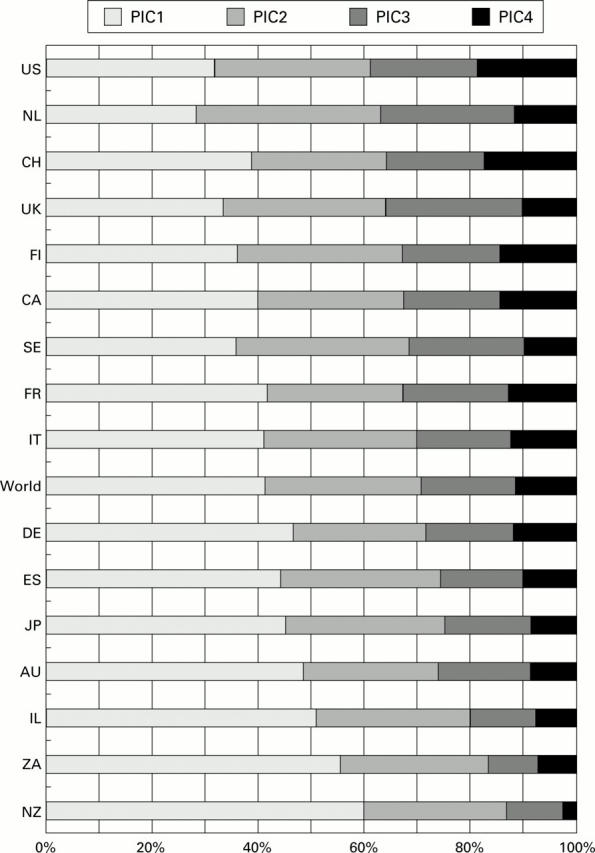
Distribution of gastroenterology papers from 16 countries (Australia (AU), Canada (CA), Finland (FI), France (FR), Germany (DE), Israel (IL), Italy (IT), Japan (JP), the Netherlands (NL), New Zealand (NZ), South Africa (ZA), Spain (ES), Sweden (SE), Switzerland (CH), the UK, and the USA) and the world by potential impact category (PIC, 1=low to 4=high): 1997-98.
Figure 3 .
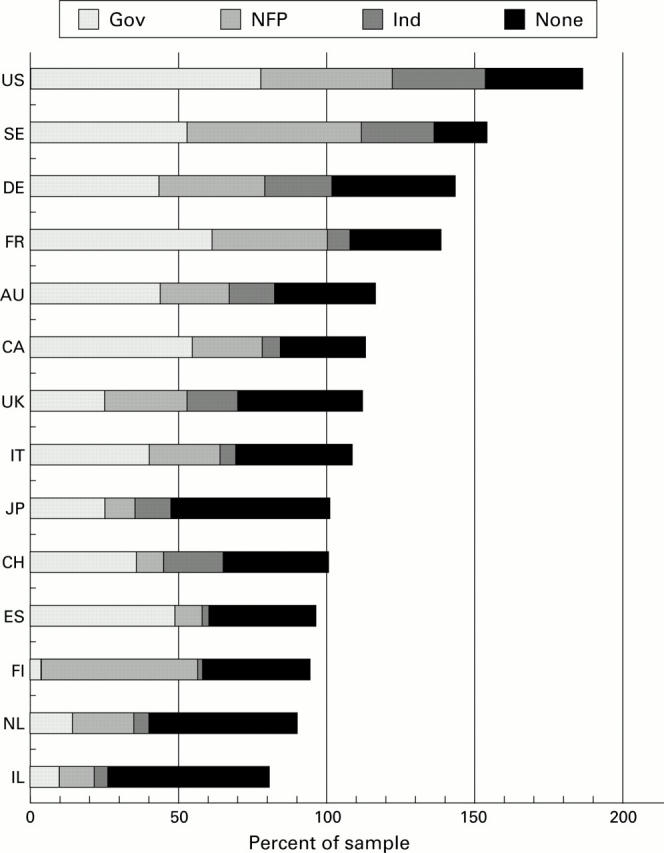
Funding sources (national government (Gov), national private non-profit (NFP) sources, industrial (Ind), and no funding) for samples of gastroenterology papers from 14 countries (Australia (AU), Canada (CA), Finland (FI), France (FR), Germany (DE), Israel (IL), Italy (IT), Japan (JP), the Netherlands (NL), Spain (ES), Sweden (SE), Switzerland (CH), the UK, and the USA): 1995 except for AU for which data are for 1993-94.
Figure 4 .
Relative commitment to gastric oncology (GASTR+ONCOL) research 1995-98 compared with death rate from gastric cancer 1993-95 for 14 countries (Australia (AU), Canada (CA), Finland (FI), France (FR), Germany (DE), Israel (IL), Italy (IT), Japan (JP), the Netherlands (NL), Spain (ES), Sweden (SE), Switzerland (CH), the UK, and the USA).
Figure 5 .
Relative commitment to non-oncology gastroenterology (GASTR but not in ONCOL) research 1995-98 compared with death rate from other gastric causes 1993-95 for 14 countries (Australia (AU), Canada (CA), Finland (FI), France (FR), Germany (DE), Israel (IL), Italy (IT), Japan (JP), the Netherlands (NL), Spain (ES), Sweden (SE), Switzerland (CH), the UK, and the USA).
Figure 6 .
Comparison of observed and calculated mean potential impact category (PIC) values for gastroenterology papers from 16 countries (Australia (AU), Canada (CA), Finland (FI), France (FR), Germany (DE), Israel (IL), Italy (IT), Japan (JP), the Netherlands (NL), New Zealand (NZ), South Africa (ZA), Spain (ES), Sweden (SE), Switzerland (CH), the UK, and the USA) and the world: 1997-98. A, number of authors per paper; D, number of addresses per paper; F, number of funders per paper; RL, research level.
Selected References
These references are in PubMed. This may not be the complete list of references from this article.
- Lewison G. Gastroenterology research in the United Kingdom: funding sources and impact. Gut. 1998 Aug;43(2):288–293. doi: 10.1136/gut.43.2.288. [DOI] [PMC free article] [PubMed] [Google Scholar]
- Unidentified curved bacilli on gastric epithelium in active chronic gastritis. Lancet. 1983 Jun 4;1(8336):1273–1275. [PubMed] [Google Scholar]
- Unidentified curved bacilli on gastric epithelium in active chronic gastritis. Lancet. 1983 Jun 4;1(8336):1273–1275. [PubMed] [Google Scholar]



